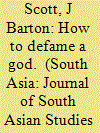|
|
|
Sort Order |
|
|
|
Items / Page
|
|
|
|
|
|
|
| Srl | Item |
| 1 |
ID:
140456


|
|
|
|
|
| Summary/Abstract |
This article argues that competing ideas about the nature of public selfhood structured the Maharaj Libel Case, as well as colonial publics more broadly. Jadunathji Maharaj had, in effect, lost his libel suit even before it went to court. For libel law, the essence of the human person is a private self that owns various forms of property, including the public persona known as ‘reputation’. For the Hindu Pushtimarg, meanwhile, the Maharaj was considered an incarnation of Krishna; his religious or public self preceded and was the ontological ground for his merely personal being. To compare these two conceptualisations of the self is to see how selfhood became an important site for the articulation of the public in colonial India.
|
|
|
|
|
|
|
|
|
|
|
|
|
|
|
|
| 2 |
ID:
153349


|
|
|
|
|
| Summary/Abstract |
Following a well-established research tradition on court decisions, this study analyses 524 defamation cases in China from 1993 to 2013, explores the media's success possibilities, and investigates the role of party capacity, political influence and the medium effect. Contrary to the existing assertions, we find that the media are not necessarily losing. On average, from 1993 to 2013, the success rate of news media in Chinese defamation courts was 42 per cent, and this rate has been increasing since 2005. We also find that government officials and Party organs had consistent advantages in court, while ordinary plaintiffs, magazines and websites had less success. The medium of the media (i.e. print, broadcast, internet) makes a difference, as do the government policies governing the media. In addition, local protectionism exists, but it is less rampant than expected. These findings compel us to rethink the dynamics among the media, the courts and the state, and their implications on China's institutional resilience.
|
|
|
|
|
|
|
|
|
|
|
|
|
|
|
|
|
|
|
|
|